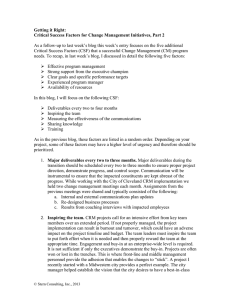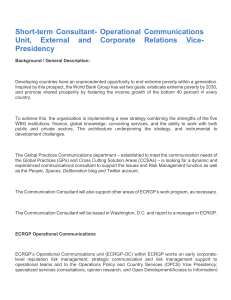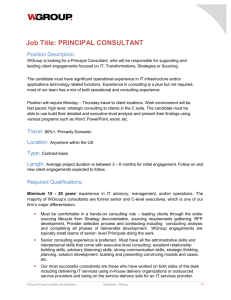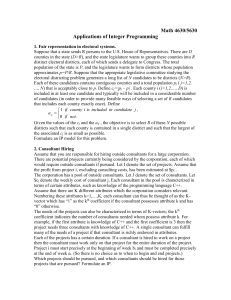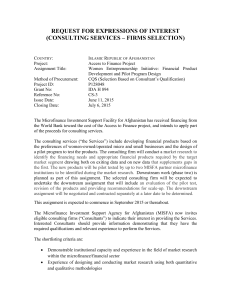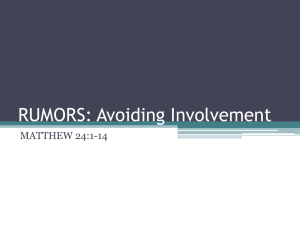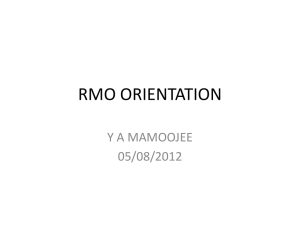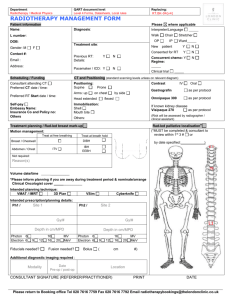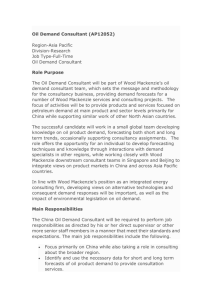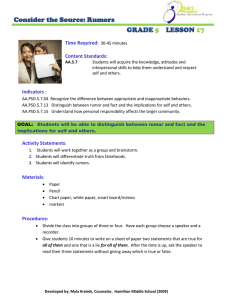Whosoever Desires Constant Success must
advertisement
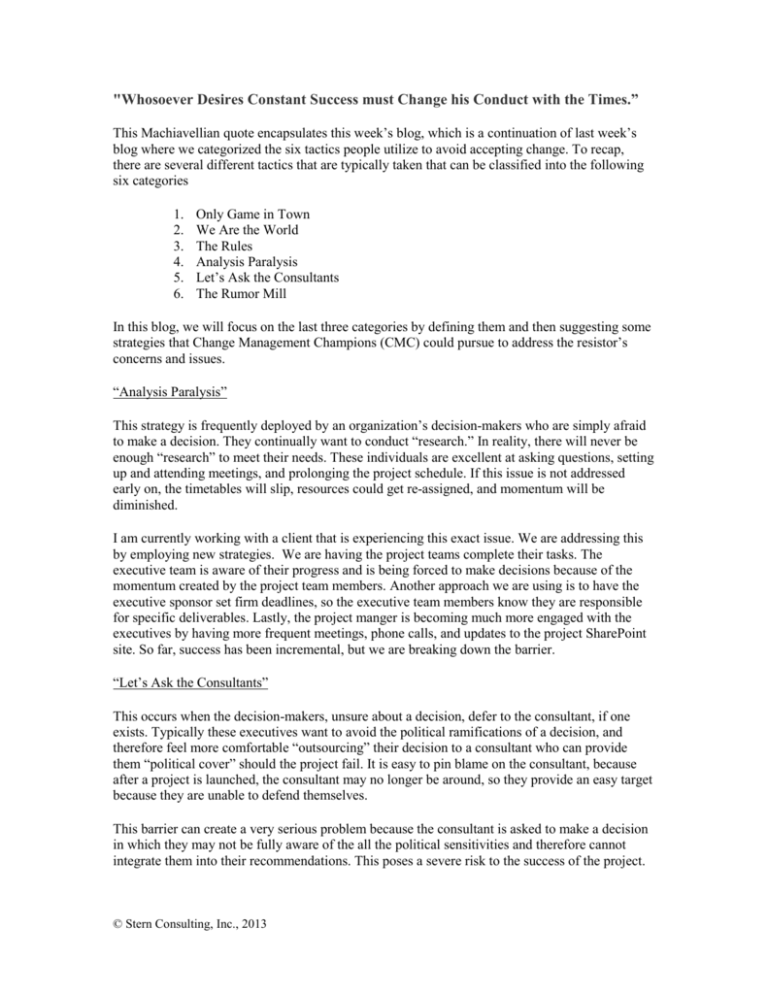
"Whosoever Desires Constant Success must Change his Conduct with the Times.” This Machiavellian quote encapsulates this week’s blog, which is a continuation of last week’s blog where we categorized the six tactics people utilize to avoid accepting change. To recap, there are several different tactics that are typically taken that can be classified into the following six categories 1. 2. 3. 4. 5. 6. Only Game in Town We Are the World The Rules Analysis Paralysis Let’s Ask the Consultants The Rumor Mill In this blog, we will focus on the last three categories by defining them and then suggesting some strategies that Change Management Champions (CMC) could pursue to address the resistor’s concerns and issues. “Analysis Paralysis” This strategy is frequently deployed by an organization’s decision-makers who are simply afraid to make a decision. They continually want to conduct “research.” In reality, there will never be enough “research” to meet their needs. These individuals are excellent at asking questions, setting up and attending meetings, and prolonging the project schedule. If this issue is not addressed early on, the timetables will slip, resources could get re-assigned, and momentum will be diminished. I am currently working with a client that is experiencing this exact issue. We are addressing this by employing new strategies. We are having the project teams complete their tasks. The executive team is aware of their progress and is being forced to make decisions because of the momentum created by the project team members. Another approach we are using is to have the executive sponsor set firm deadlines, so the executive team members know they are responsible for specific deliverables. Lastly, the project manger is becoming much more engaged with the executives by having more frequent meetings, phone calls, and updates to the project SharePoint site. So far, success has been incremental, but we are breaking down the barrier. “Let’s Ask the Consultants” This occurs when the decision-makers, unsure about a decision, defer to the consultant, if one exists. Typically these executives want to avoid the political ramifications of a decision, and therefore feel more comfortable “outsourcing” their decision to a consultant who can provide them “political cover” should the project fail. It is easy to pin blame on the consultant, because after a project is launched, the consultant may no longer be around, so they provide an easy target because they are unable to defend themselves. This barrier can create a very serious problem because the consultant is asked to make a decision in which they may not be fully aware of the all the political sensitivities and therefore cannot integrate them into their recommendations. This poses a severe risk to the success of the project. © Stern Consulting, Inc., 2013 To help mitigate this issue, it is important to establish a clear governance process for the executives. They need to understand that they are accountable for the decisions made, not the consultants. A previous client was experiencing this issue where they wanted to outsource a decision to a software implementation consultant who was not capable of making a recommendation. In this instance, the executive sponsor called an impromptu after hours meeting with the executive team and reminded them of their role in the project and his expectations of their deliverables. The sponsor stated the implementation decision was theirs, that they must take ownership for the decision, and that they will be held accountable for the decisions. This meeting helped re-center the executive team and ensured that they would be making the critical project decisions, not the external consultant. The role of consultants is to advise, not decide. “The Rumor Mill” This is similar to something that occurs in everyday life. In the absence of facts, people choose to create their own. When communication gaps exist, employees create their own facts, frequently with the intent to derail a project as the rumors typically portray the project in a negative light. If rumors go unchecked project support could wear away quickly. To help tackle this issue organizations should develop a channel(s) where feedback can be processed and addressed. A client I am currently working with holds frequent brown bag lunches and “town hall meetings” to address rumors that the project team has become aware of. In addition, technology (blast email, SharePoint sites, and social media) should be leveraged to quash rumors as it remains the most rapid approach available. Remember that utilizing frequent communication in different settings can be successfully leveraged to prevent false rumors from going viral. The key theme in addressing these three types of resistors is to engage them, listen emphatically to their concerns, and provide multiple channels for communicating. Also, do not be afraid to use the “hammer” and get the executive sponsor engaged where appropriate. However, do not abuse this hammer as that could lead to other project concerns, which will be discussed in another blog. Tune in next week when we cover a new topic, Resistance Mitigation Strategies to Utilize. This blog will be especially helpful for the CMCs who are responsible for leading change within their organizations. We will identify the specific tactics to utilize and share examples where they have been successfully deployed. As with last week, I close with the following questions: 1 – What other resistance reasons and strategies have you seen utilized by employees? 2 - What are some of the mitigation approaches you have seen successfully deployed? Spencer Stern specializes in assessing the business and process impact of new technology-based solutions, ranging from enterprise-wide software systems to wireless communications networks. In 2008 he launched Stern Consulting where he continues to focus on assessing the financial impact of large-scale municipal strategic implementations. He can be reached at: spencer@sternconsultinginc.com For more information, please visit: © Stern Consulting, Inc., 2013 www.sternconsultinginc.com © Stern Consulting, Inc., 2013
